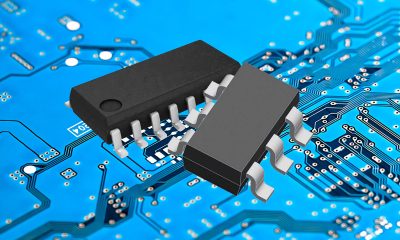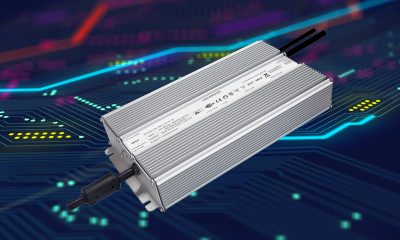No matter which lighting technology is used, the ability to effectively control the output of a light source is essential. No matter which lighting control strategy is used, dimming is, in most cases, an indispensable tool to accomplish that goal. Dimming refers to operation of adjusting the lumen output or changing the perceived brightness of a light source. The advent of solid state lighting based on LED technology opens up a host of advanced control opportunities. The instantaneous response of LEDs to changes in power input lends them perfectly to dimming control. Today, light source dimming is no longer merely used to maximize energy efficiency and enhance visual perception. The trend towards the interaction of lighting control with IoT devices calls for a robust dimming solution which can support the most sophisticated lighting scenarios. And these advanced applications can only be realized through LED dimming.
How Essential is LED Dimming?
The importance of LED dimming is beyond what most people would ever imagine. Today’s lighting revolution is spurred on by LED technology. LED’s superior controllability and its ability accommodate the integration of sensors, processors, and network interface enables functional, flexible, adaptive and intelligent lighting. Dimming technology is ubiquitously utilized to unlock the power of LED lighting:
Increasing energy savings
Dimming can maximize energy efficiency of lighting by offering the right amount of light. Aside from light management through manual adjustment of individual lights and programmed scenes that incorporate multiple luminaires, a tremendous opportunity exists to save energy and reduce operating expenses through the use of automated controls. Interfacing with a building management system (BMS) or a home automation system enables programmed adjustment of light output. Integration with occupancy sensors, vacancy sensors, photosensors, and/or time clocks allows dimming operation to be automatically triggered.
Customizing light scenes
Dimming control plays an important role in the lighting design process. With variable light output, lighting designers can create dynamic layers of light, balance the distribution of light, reinforce design aesthetics, and enhance the comfort and performance of tasks. Dimming is frequently used in spaces where flexibility is important and the ability to create different scenes is highly desired. Adjustment of luminous intensity can help create an environment with the most sought-after ambiance throughout the day or event. Dimming can also alter the spectral composition of light. Dim-to-warm lighting can replicate the familiar glow of incandescent lamps as they are dimmed to a lower intensity, thereby creating a comfortable, intimate ambiance in restaurants, hotels, and high-end residences.
Human centric lighting (HCL)
The discovery of the biological influence from light created the concept of human centric lighting which simulates the spectral quality and intensity of natural daylight over the entire day to support the human circadian rhythm and keep natural melatonin production in balance. HCL utilizes tunable white technology to modulate the color temperature of white light, within luminous intensity controlled independently. Tunable white systems are equipped with cool white and warm white LEDs. The light of these LEDs is mixed in different proportions by adjusting the current ratio between the LED channels. In doing so the correlated color temperature (CCT) of light can be customized along the planckian curve, for example, from 2,700 to 6,500 Kelvin.
Full color tuning
Also known as additive color mixing, full color tuning refers to the mixing of the three primary colors of visible light (red, green, and blue) in various degrees of saturation to create secondary colors. We all know to layer colors on top of each other for combinations of different wavelengths to create the diversity of colors. In color production with LEDs, dimming technology is used to dynamically adjust the intensity of each primary color, such that different colors can be created from a single LED module. To produce predictable colors from RGB, RGBA or RGBW systems, each of the LED channel requires accurate dimming control.
Extended service life
For LED luminaires with their LEDs driven at a relatively high current, long time operation can cause excess heat buildup which will lead to phosphor thermal degradation and premature aging of the LEDs. The dimmed load alleviates the LEDs from thermal stress resulted from continuous, full drive current operation, and thus helps prolong the service life of LEDs. Intelligent LED drivers are equipped with module temperature protection (MTP) devices to monitor the temperature of the LEDs and dim the load to a low level when necessary.
How LED Dimming Works
LEDs are current driven devices which produce light when electrical current flows therethrough. Since LEDs do not operate on an alternating current (AC) power supply, LED drivers are used to convert the AC mains power into a low voltage constant current needed for the LEDs. There is a quasi-linear relationship between the current applied to a LED and the light output of the LED. It is therefore the task of the LED drivers to regulate the current flowing through the LEDs and allow the light output to be adjusted accordingly. Not all LED drivers are able to provide a variable load. Only those designed to recognize and respond to the control signals are capable to dim the LEDs. The dimming process consists of two stages: a dimming circuit (dimmer) or control device sends a dimming request in the form of control signals to a driver, which then interprets the control signal and regulates the load to LEDs as requested.
How LEDs are dimmed
LED drivers can be configured to dim the LEDs in two ways:
- Pulse-width modulation (PWM)
- Constant current reduction (CCR)
Pulse-width modulation (PWM)
Pulse-width modulation (PWM) switches the LED current at a high frequency between 0 and the rated output current to adjust LED brightness. PWM dimming relies upon the human eye’s ability to assimilate the average amount of light in the pulses. The perceived brightness is approximately proportional to the duty cycle of the pulses (the ratio of the on-time and off-time). The continuous stream of pulses is modulated at a frequency high enough to be imperceptible to the human eye or even to high speed video cameras. Pulse-width modulation dimming can be used for LED arrays that run off either constant voltage (CV) drivers or constant current (CC) drivers.
A PWM driver will only operate the LEDs at the rated forward current level or zero. As such, the CCT of the LEDs is maintained throughout the dimming range. The consistent CCT simplifies the color mixing process. Since the LEDs are always on at the same current level, a very precise output level can be achieved. All these advantages make PWM dimming particularly viable for RGB full color tuning applications. PWM is also an energy efficient current modulation method because it periodically switches between a full-amplitude current and a zero current thus reducing the running time of the LEDs.
The primary disadvantage of PWM dimming is that high frequency switching can generate electromagnetic interference (EMI) and audible noise. In addition, PWM drivers cannot be remote mounted as the changes in capacitance and induction owing to increased transmission distance can end up in interference with high frequency control.
Constant current reduction (CCR)
Constant current reduction (CCR) or analog dimming control the light output of the LEDs by adjusting the current flowing continuously to the LEDs. The amount of light output is approximately proportional to the current flowing through the LED. CCR addresses the fundamental issues associated with PWM dimming and can be used in applications with strict EMI requirements. CCR drivers are immune to the stray characteristics of the wire (capacitance and inductance) and can be mounted remotely from the light source. Their higher output voltage limit (60V) as opposed to drivers that use PWM (24.8V) gives CCR drivers an another advantage as UL Class 2 drivers for dry and damp locations. Without pulsing from the fast rising and falling edges as with a PWM driver, CCR drivers can be used in photography, videography, and machine-vision applications where the camera shutter speed or video scan rate must be in sync with the flicker frequency.
At higher currents the light output of CCR operated LED luminaire does not increase as quickly or exhibit a linear change in light output as the drive current because of the droop effect. When dimming with CCR, the LEDs are driven below the rated current. As a result, color shift can occur. Failing to deliver precise light output and CCT makes analog dimming unfavorable in color mixing applications wherein precise levels for each color need to be maintained. At very low currents (below 10%), analog dimming may not perform well and light output may vary. Therefore it’s not common for LED luminaires with CCR drivers to be dimmed to levels below 10%.
CCR dimming circuitry can be controlled through a variety of protocols, including 0-10V, DALI, and ZigBee. However, CCR does not work with constant voltage drivers.
Dimmer-to-driver control
The ultimate challenge around LED dimming is to provide a smooth, wide-range dimming curve to satisfy the human eye and machine vision. Yet dimming technologies today can be confusing and dimming controls can be tricky to implement. There’re a selection of signaling protocols and dimming methodologies for dimmer-to-driver lighting control. These control solutions have their corresponding application requirements. Oftentimes end-users experience light flickering, pop-on or drop-out because of the incompatibility between dimmers and drivers. Dimmers which work for legacy lighting may not work for LED lighting. And dimming control using the latest protocols may present problems because the inadequately defined electrical characteristics make products from different manufacturers considerably less interchangeable. It is best to verify dimmer compatibility and distinguish the dimming conditions prior to specifying the products.
The most commonly used methods for dimmer-to-driver signal initiation:
- 2-Wire (Forward Phase)
- 2-Wire (Reverse Phase)
- 3-Wire (Lutron)
- 4-wire (0-10V)
- DALI
- DMX
Phase control dimming
Phase control dimmers operate by cutting out a portion of the AC waveform to limit the amount of voltage and current supplied to a lamp. Because these dimmers typically cut voltage phase over the current peak as required by the load, they are often referred to as phase control or phase-cut dimmers. This type of dimming circuits works especially well with incandescent lamps and other lighting devices that present a resistive load to the dimmer. In contrast, most LED drivers contain reactive components, such as coils and capacitors, which present a reactive load to the dimmer. Unless the LED driver is designed to recognize and respond to the voltage signals from phase control dimming circuits in a desirable way, dimming LEDs with conventional control circuits is likely to produce undesired effects, such as low end drop out, misfiring, blinking, flickering, and large steps in light output. Phase control dimmers are available in following categories:
- 2-wire forward phase (leading edge) dimmers utilize a high-speed bidirectional thyristor device to cut out a portion of the AC waveform at the leading edge of each half sine wave. The thyristor device is usually a triac (triode for alternating current) or SCR (silicon controlled rectifier) which is capable of switching and controlling AC power in both directions of a sinusoidal waveform. In order for the triac to maintain its conducting state, the dimmer needs to be fired with a minimum holding current of between 30-50 mA. An LED light source may not draw enough current to trigger the triac. As a result, when connected to a triac dimmer, an LED lamp may work inconsistently and significant ringing may occur as a consequence of the input capacitance being charged by the inrush current and the relatively large impedance introduced to the input line by the LEDs. Therefore, only LED drivers specially designed to eliminate the problems associated with using leading edge dimmers can operate the LED lamps. Some LED drivers take enough extra current from a dummy load or “bleeder circuit” to keep the triac conducting. Because dimming control is effectively created without a separate communication link, triac dimmers are often used in retrofit applications where pulling new or additional circuit wiring to accommodate dimmers with dedicated signal wires can be complicated or expensive.
- 2-wire reverse phase (trailing edge) dimmers was originally designed to control electronic low voltage (ELV) transformers which create reverse phase waveforms. A reverse phase dimmer chops a portion of the voltage signal waveform at the trailing edge of each half power cycle of the input. The dimmer uses a MOSFET or IGBT circuit to turn conduction off at a preset amount of time after the natural zero point of the AC shine wave. ELV transformers are typically used to operate low-voltage MR16 lamps. In retrofit applications, the driver of an MR16 LED lamp is connected the ELV transformer. For reverse phase dimmers to operate on ELV transformers with LED loads, a sufficiently large resistive load should be provided to meet the minimum wattage requirements of ELV transformers. The input capacitance of the LED load must be reduced to a minimum to prevent high repetitive peak current flow from the transformer to the load.
- 3-wire (switched hot, dimmed hot, and neutral) forward phase dimmers have a separate line voltage wire that carries the phase control dimming signal. The presence of this electrical return path makes the dimmers less susceptible to electrical noise and allows the drivers to stay synchronized with the input AC waveform. The LED driver has to be specifically rated for the 3-wire control scheme.
4-wire (0-10V) dimming
0-10V control is a 4-wire (Hot and Neutral, plus 2 low-voltage control wires) scheme that uses an analog low-voltage signal to adjust the output of the attached load. There are two types of 0-10V controls: current source and current sink. The current source dimming is a front-end (user driven) method of lighting control intended for theatrical and entertainment applications. What we are discussing about is the current sink method, a back-end protocol designed for architectural lighting fixtures. In this method, the LED driver is the current source for the DC signal and the dimmer is the point of reference. The low voltage pair of wires consists of a purple wire (+10VDC) and a grey wire (Signal Common). The driver associates the input voltage, which is adjusted by varying the voltage between 1 volt (minimum level signal) and 10 volts (maximum light), to a particular dimmed load. When these two wires are open, the driver receives a 10V dimming signal and outputs 100% of the rated load. When the purple and grey wires are shorted together, the driver receives a 0V dimming signal and the output of the driver will be set to the minimum. If a level of 60% is set, the dimmer would sink the signal voltage to 6V. This method is also known as 1-10V dimming since 1 volt is the minimal level signal, and 0V turns the lamp off as the driver will drop in to sleep mode. Most 0-10V dimmable drivers dim from 100% to 10% apparent output.
Unlike phase control dimmers which cut power in the line voltage to the fixture, 0-10V dimming occurs in the driver and thus no heat is generated in the dimmer and transmitted across the wires. This attribute allows 0-10V dimmable LED drivers to control larger loads. The low voltage control wires are polarity sensitive. Long wire runs can cause a signal level drop, resulting in non-uniform light output from light fixtures which are operated by different drivers and controlled by the same control device. Another problem with 0–10V dimming is that 0-10V dimming standards for architectural applications in the US do not adequately define the value of the minimum light output, nor does it address the shape of the dimming curve. This means that adjusting the 0-10V signal with dimmers from different manufacturers will not necessarily achieve uniform dimming across different LED luminaires. What’s worse is that poor compatibility among dimmers and drivers can present a new level of challenges.
Digital Addressable Lighting Interface (DALI)
DALI was created to provide central control of light fixtures over a single pair of wires which operates at approximately 16VDC and carries a digital signal from a DALI controller to an LED driver. The other two wires provide a constant line voltage to the driver. This interface protocol for digital communication allows addressing, grouping, and dimming of up to 64 light fixtures and control devices. Its ability to communicate with the light fixtures individually, collectively or in groups via bi-directional data exchange provides great flexibility for light management. A DALI system can digitally assign occupancy sensors, photocells, time clocks, and other control devices to one or many fixtures without complicated wiring. DALI addresses the need for multilayer lighting control which requires light fixtures to respond to more than one controller and to be assigned to more than one control zones simultaneously.
The protocol uses logarithmic dimming with the curve matched to the sensitivity of the eye. DALI dimming technology uses 8-bit resolution for 254 individual steps, allowing users to obtain very precise output control with a dimming range of 0.1% to 100%. Both RGB color mixing and color temperature tuning are now supported. Robust color control and automated dimming allow multiple light scenes to be called up for a room and dynamically presented in steps with variable durations.
DALI control lines have no polarity, which provides simplicity of installation. The DALI system uses a balanced pair of wires as the control bus and Manchester encoding for data-modulation. Therefore the digital signal is immune to external interference, all light fixtures in a DALI lighting system can be uniformly dimmed.
DMX
DMX or DMX512, originally developed for entertainment and stage lighting applications, is now widely used to bring the drama and excitement of theatrical lighting into interior and exterior architectural spaces. DMX employs EIA-485 (RS-485) differential signaling at its two-wire physical layer. This variable-size, packet-based communication protocol has a transmission rate of 250 kBit/s. The unidirectional, channel-based protocol streams data continuously in a sequence of up to 512 data frames (slots) for up to 512 channels. Each DMX512 dimming channel controls one recipient and transmits data in 8 bits giving 256 steps of color depth. DMX is typically used to control RGB LEDs, which takes up three channels from the DMX512 stream to control one triplet. Data is transmitted over a cat5 or 3-core shielded cable which is polarity dependent. Remote device management (RDM) is an enhancement to the DMX protocol that allows bidirectional communication between a lighting controller and RDM-enabled light fixtures.












Loading...